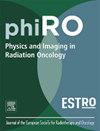基于机器学习的时间和光谱提示伽马射线信息集成,用于质子距离验证
IF 3.4
Q2 ONCOLOGY
引用次数: 0
摘要
背景与目的:提示伽玛射线计时(PGT)和提示伽玛射线光谱学(PGS)是质子放疗中监测剂量传递的无创技术。将PGT和PGS整合到统一的数据分析框架中,可以通过结合来自提示伽马射线事件的时间和光谱信息来改进质子距离验证。本研究评估了这种集成的有效性,以提高使用机器学习的质子距离验证的准确性。材料与方法:用162 MeV和225 MeV的静态质子束和扫描质子束照射均匀体。引入5,10和20mm的空腔来模拟解剖变化。使用PGT探测器测量提示伽马射线的能量和到达时间。提取了1440个质子点的二维时能谱。计算了不同的特征集(纯能量、纯时间、限能时间、图像)。四种不同的机器学习模型使用这些特征集来预测范围变化。使用均方根误差(RMSE)评估模型性能。结果:仅时间和组合时间-能量特征集的RMSE值为3 ~ 4 mm,与先前开发的模型一致,表现出良好的性能。当RMSE值超过5 mm时,仅能量和图像特征会导致性能变差。与仅使用时间特征相比,仅使用能量特征的集成并没有提高预测精度。结论:虽然光谱信息对确定所研究的装置中的质子束范围位移没有贡献额外的价值,但研究结果表明,仅时间信息就足以进行准确的质子范围验证。本文章由计算机程序翻译,如有差异,请以英文原文为准。
Machine-learning-based integration of temporal and spectral prompt gamma-ray information for proton range verification
Background and Purpose:
Prompt gamma-ray timing (PGT) and prompt gamma-ray spectroscopy (PGS) are non-invasive techniques for dose delivery monitoring in proton radiotherapy. Integrating PGT and PGS into a unified data analysis framework may improve proton range verification by incorporating both temporal and spectral information from prompt gamma-ray events. This study evaluates the effectiveness of this integration for enhancing the accuracy of proton range verification using machine-learning.
Material and Methods:
A homogeneous phantom was irradiated with 162 and 225 MeV static and scanned proton beams. Air cavities of 5, 10 and 20 mm were introduced to simulate anatomical variations. The energy and time of arrival of prompt gamma rays were measured using a PGT detector. 2-dimensional time-energy spectra were extracted for 1,440 proton spots. Different feature sets (energy-only, time-only, energy-restricted time, image) were computed. These feature sets were used by four different machine-learning models to predict range shifts. Model performance was assessed using the root mean square error (RMSE).
Results:
Time-only and combined time-energy feature sets exhibited good performance with RMSE values of 3 to 4 mm, consistent with previously developed models. Energy-only and image features led to poorer performance with RMSE values exceeding 5 mm. The integration of energy-only features did not improve prediction accuracy compared to exclusively using time-only features.
Conclusion:
While spectral information did not contribute additional value for determining proton beam range shifts in the investigated setup, the findings show that temporal information alone is sufficient to perform accurate proton range verification.
求助全文
通过发布文献求助,成功后即可免费获取论文全文。
去求助
来源期刊

Physics and Imaging in Radiation Oncology
Physics and Astronomy-Radiation
CiteScore
5.30
自引率
18.90%
发文量
93
审稿时长
6 weeks
 求助内容:
求助内容: 应助结果提醒方式:
应助结果提醒方式:


